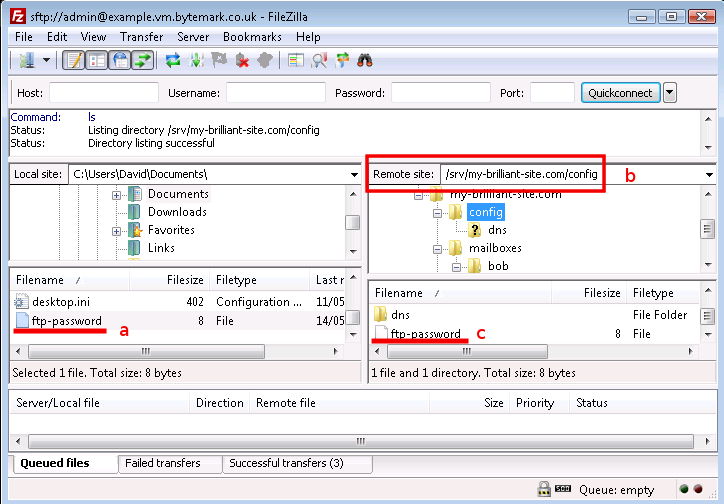Table of Contents
What is FTP Access?
FTP (File Transfer Protocol) is a standard protocol used to transfer files between a client and a server over the Internet.

- FTP access refers to the ability to connect to an FTP server to upload, download, delete, rename, and manage files.
- It allows you to access and manipulate files on a remote server just as you would files stored locally on your own computer.
Here are some key things to know about FTP access:
- Client-Server Model – FTP uses a client-server architecture with an FTP client software connecting to an FTP server.
- Port 21 – FTP servers typically listen on port 21 for connection requests from clients.
- Supports Authentication – FTP access requires login credentials to access files and folders according to set permissions.
- Text-based – FTP is a text-based protocol that uses ASCII commands for all operations.
- No File Size Limits – FTP does not impose file size limits, allowing transfer of large files.
Overall, FTP access enables efficient and automated file transfers between systems using FTP client and server software.
Understanding the basics helps use it effectively.
Why Do You Need FTP Access?
There are many good reasons why website owners need access to their server files through FTP:
- Update Website Content – Add, edit, delete pages, blog posts, images through FTP clients instead of a control panel.
- Install Web Applications – Upload and configure applications like WordPress or Drupal via FTP.
- Website Maintenance – Upgrade plugins/themes, modify .htaccess files, adjust file permissions.
- Website Migration – Download entire website directories via FTP for migrations.
- Backups – Download backups from your web server to your local machine.
- SEO – Upload sitemaps, customize robots.txt file to improve SEO.
- Access Denied Files – Admins can access all files including ones blocked for web users.
Essentially, FTP access equips you with vital controls absent in hosted control panels and content management systems.
Even if you use CMS tools, learning FTP fills important gaps in website administration:
- Troubleshoot issues like “500 internal errors” faster
- Modify image upload size limits imposed by CMS platforms
- Automate file transfers through FTP scripts for backups or migrations
- Adjust server file permissions not available in admin platforms
Whether you are a developer or business owner, unlocking FTP access paves the way for powerful website management.
Choosing an FTP Client
Once you have FTP access to your host server, an FTP client software serves as the interface to connect your computer to the remote server.
Here are popular free FTP clients worth checking out:
| FTP Client | Platform | Key Features |
|---|---|---|
| FileZilla | Windows, macOS, Linux | Open source, supports FTP/SFTP/FTPS, site manager, drag and drop transfers |
| WinSCP | Windows | Scripting and automation, integrate with file managers, remote editing |
| Cyberduck | Windows, macOS | Supports FTP, SFTP, WebDAV, AWS S3, OpenStack Swift |
| FireFTP | Firefox add-on | Open source, easy to use Firefox FTP client |
And some paid FTP clients:
| FTP Client | Platform | Pricing | Main Highlights |
|---|---|---|---|
| Transmit | Mac | $45 | UI optimized for Mac, upload accelerator |
| CuteFTP | Windows | $59.99 | Schedule transfers, site-to-site transfers, backup wizard |
| Syncplify | Windows, Mac, Linux | from $349.00 to $1,599.00 | Centralized control over multiple FTP sites, automations |
The best FTP client depends on your specific needs and budget.
For example, Filezilla is hugely popular given its reliability, features and being open source.
But Cyberduck offers greater protocol support while Transmit excels at speed.
Most paid tools emphasize better user experiences coupled with automation capabilities. Evaluate key features like:
- Protocol support (FTP, FTPS, SFTP)
- Ease transferring large files
- Site management features
- Automate transfers
- Central dashboard
- Security compliance e.g. OpenPGP
So carefully weigh what’s most important before picking an FTP client.
Connecting to an FTP Server
To access your hosting account files, the main prerequisites are:
- Active hosting account providing FTP access
- Public server IP address
- FTP login credentials (username and password)
Many web hosts provide this easily or have an option to create FTP accounts separately.
Once you have those – configuring an FTP connection follows these core steps:
- Launch your chosen FTP client software
- Enter FTP server details (Hostname/IP, Port)
- Specify FTP username and password
- Select appropriate connection mode – FTP, SFTP, FTPS etc.
- Click “Connect”
Let’s elaborate the key parts:
- Hostname/IP – Domain or IP address of your hosting account.
- Example Hostnames: ftp.yourdomain.com, files.hostingcompany.com
- Port – Typically port 21 for default FTP servers using plain/unencrypted FTP protocol. SFTP uses port 22.
- Connection Mode
- FTP – Unencrypted connection (not secure)
- SFTP (SSH File Transfer Protocol) – Encrypted secure FTP over SSH
- FTPS (FTP-SSL) – Explicit FTPS is an encrypted version using longer port range like 900+
- Login Credentials – The FTP username and password provided by your host
Advanced FTP clients allow saving these details as site/connection profiles, simplifying reconnects.
(Optional) Passive FTP
Additionally, enable “Passive” mode if facing connection issues – this avoids potential firewall blocking.
So in a nutshell, input your host server details + credentials in your chosen client to connect successfully.
Read also: Linux VPS in South Africa: All You Need To Know
Navigating FTP Directories and Transferring Files
Once connected to your hosting account via an FTP client, you can browse directories and files much like navigating local folders on your computer.
Here are common operations for efficient FTP management:
Navigating FTP Directories
- Change directories e.g.
cd public_html - Go to parent directory e.g.
cd .. - List folder contents e.g.
ls,dir - Create new directories e.g.
mkdir myfolder
Transferring Files and Folders
- Upload files simply via drag-and-drop from your computer or use upload commands
- Download files via right-click menu or download commands
- Rename or delete files and directories
- View and edit files directly on the remote FTP server
Key FTP commands for transfers:
get filename– Download file from serverput filename– Upload file to servermput– Upload multiple files togethermget– Download full folder
Now for actual editing, you have two options:
- Download file > Edit Locally > Upload Again
OR - Edit Directly on Server using FTP Editor
Editing files directly on a remote server allows full control over your website without downloads and uploads constantly.
Good FTP software either have built-in editors or integrate easily with external ones like Notepad++, VSCode etc.
Some examples below:
| FTP Client | Editing Tools |
|---|---|
| FileZilla | Built-in editor + external editor integrations e.g. Notepad++ |
| WinSCP | Built-in editor or Remote Editor Plugin for Notepad++ & others |
| Cyberduck | Opens edits in Mac default editor |
This completes core aspects of managing FTP directories and transfers. With practice, you will be able to handle server files with the same ease as local files.
FTP Security Best Practices
While immensely useful, File Transfer Protocol in its original form does transmit data including login credentials unencrypted.
This gives rise to security vulnerabilities exposing your server files to breaches or snooping attacks.
So it’s vital to adopt security best practices using your FTP access including:
- Use SFTP/FTPS – Choose secure encrypted protocols like SFTP or FTPS instead of plain FTP. SFTP runs FTP traffic securely over SSH while FTPS adds SSL/TLS encryption.
- Unique Credentials – Have separate FTP credentials instead of using Admin or other panel logins. Also use strong randomized passwords.
- Limit Access – Restrict FTP user permissions to specific folders. Set proper file permissions.
- Passive Mode – Keep FTP client connection mode passive to avoid traffic blocking.
- Automate Actions – Schedule automated FTP scripts for backups or transfers instead of keeping open persistent sessions.
- IP White-Listing – Whitelist specific IP(s) permitted to connect via FTP access only.
- VPN Tunneling – Tunnel your FTP connection through a Virtual Private Network (VPN)
- Disable when not in use – Temporarily disable FTP users when not actively needed to close security gaps.
Also ensure your FTP software remains updated and configured to match latest security standards.
Being prudent with your remote file access goes a long way in prioritizing server security.
Read also: Step-by-Step Guide to Flawless Drupal Hosting Setups
Troubleshooting Common FTP Issues
Despite best practices, you may face hiccups with your FTP client struggling to connect or transfer files from hosting accounts.
Here are some common FTP errors and fixes:
- Timeout errors – Server not responding. Retry later as may be temporary network or server issue.
- “Connection refused” errors
- Verify Hostname/IP and other details are correct
- Check for server-side restrictions on IPs or credentials
- Try toggling between Active/Passive modes
- Login failed errors
- Double check account username & password
- Certain special characters may need escaping
- Check for blocks on IP or account
- “File transfer stalled” errors – Upload/download large files timing out
- Break transfer into smaller chunks
- Compress file and upload
- Toggle TCP window size in advanced settings
- Can’t edit/save file errors – Permission issues direct editing
- Download > Edit > Upload file workflow
- Get admin to modify permission
Monitor error messages closely applying relevant solutions. Also reach out to your host support to resolve persistent FTP problems.
Key Takeaways:
- FTP access allows managing hosting server files easily for tasks like migrating websites, installing applications or editing site content.
- Using a dedicated FTP client simplifies website administration avoiding hosting control panel limitations.
- Connecting an FTP client involves inputting server hostname/IP, an FTP username and password provided by your host.
- Secure protocols like SFTP and FTPS prevent data breaches by encrypting FTP traffic for privacy.
- Automate FTP workflows instead of keeping manual sessions open to minimize security risks long term.
- Common FTP errors relate to login failures, timeouts or file transfer issues and often have fixes like verifying details or changing connections mode.


